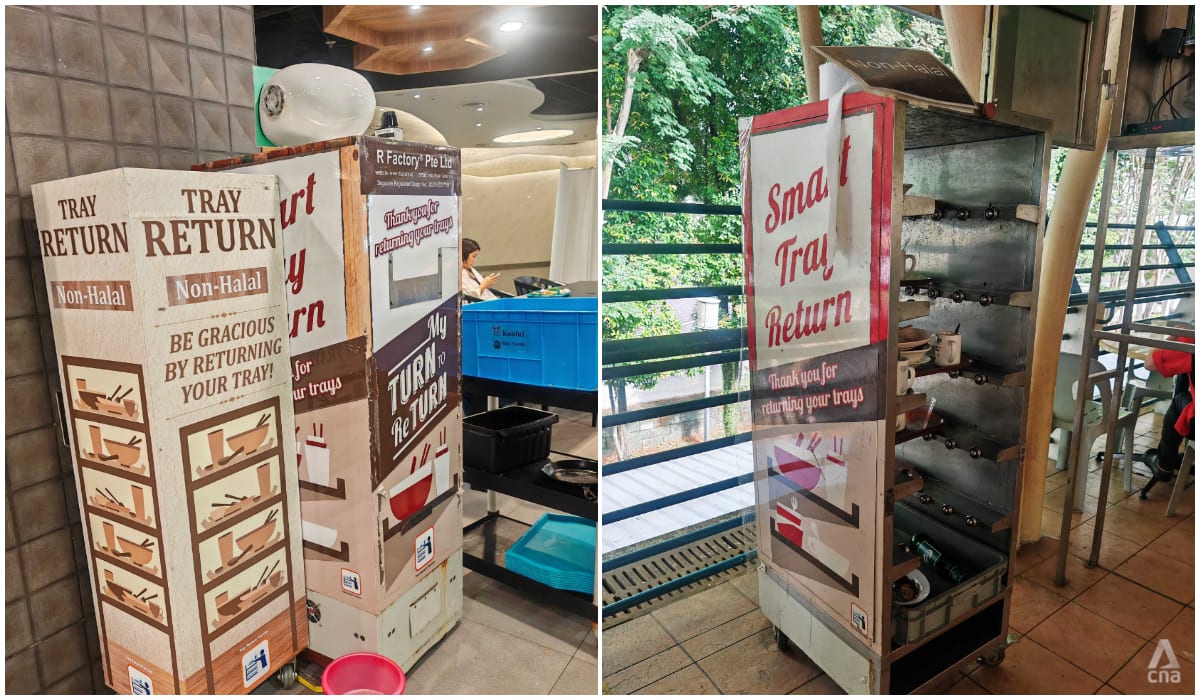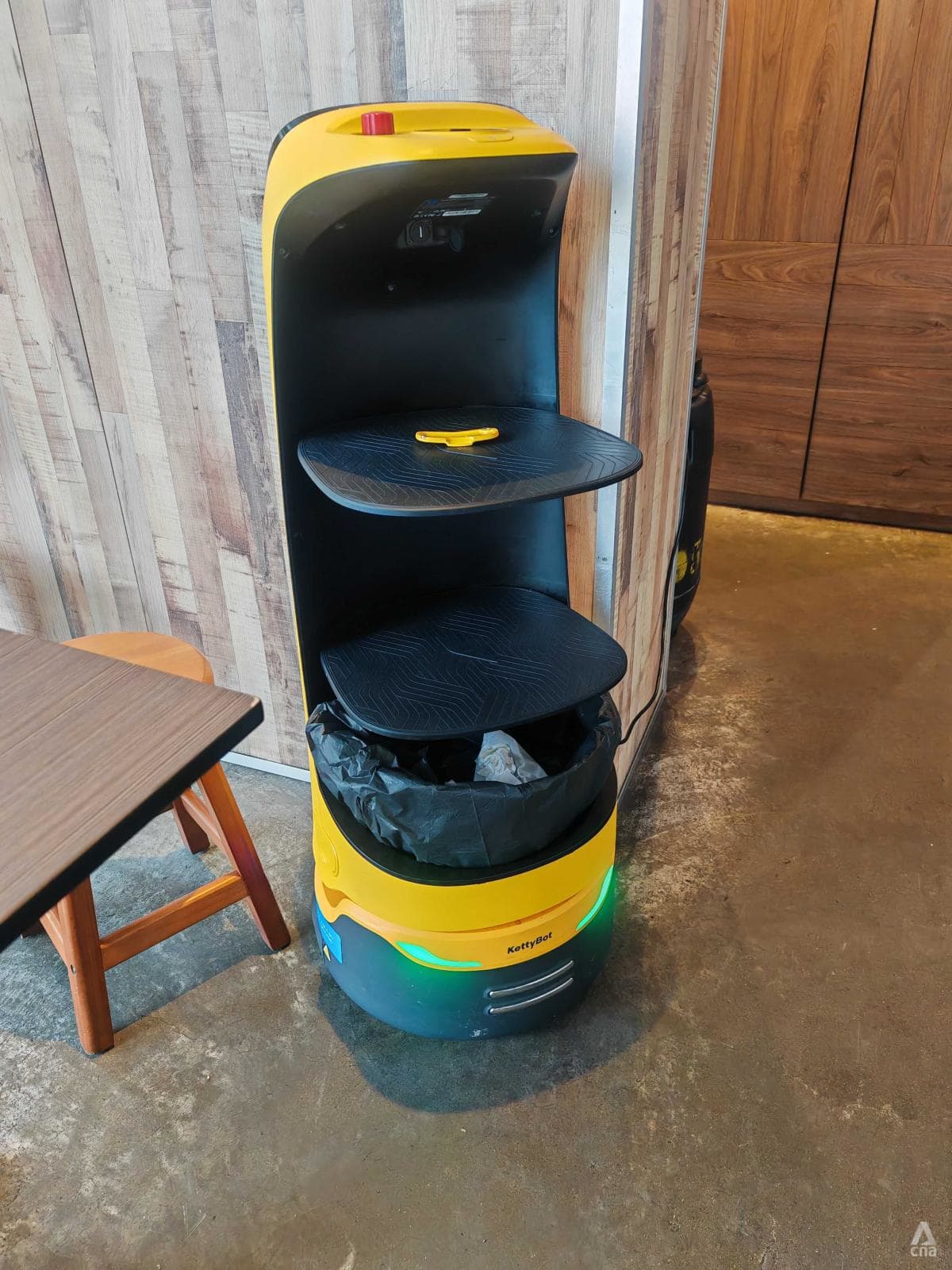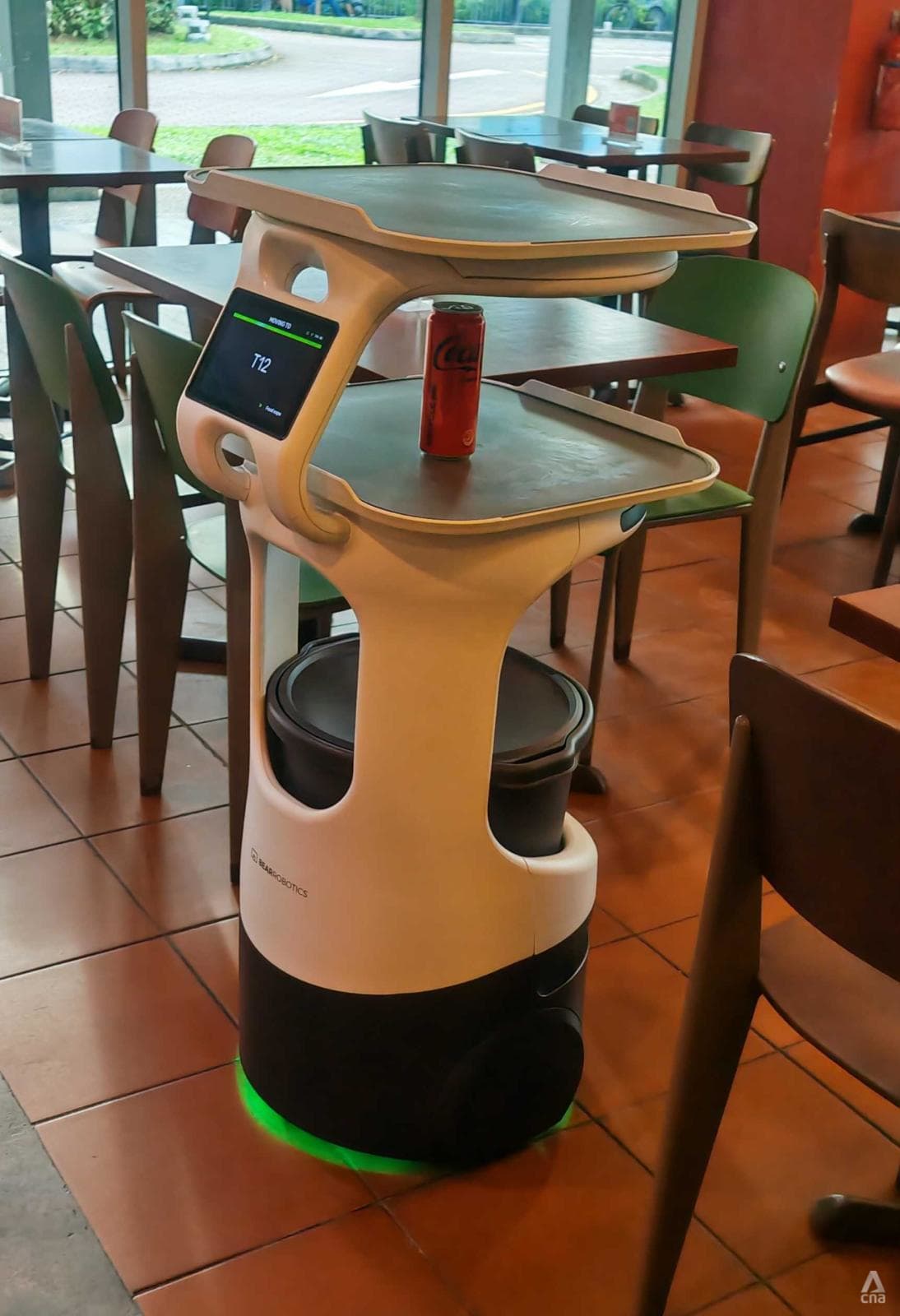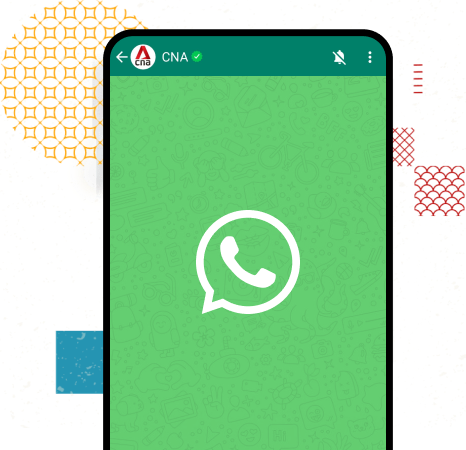Why tray-return robots have disappeared from food courts
Tray-return robots used to rove around food courts to help customers return their used crockery, but most have disappeared or have been converted into stationary tray-return points.

A roving tray-return robot in 2017 (left) and a similar robot that has been turned into a tray-collection station at a food court in 2024. (Photos: TODAY/Nuria Ling, CNA/Koh Wan Ting)
This audio is generated by an AI tool.
SINGAPORE: Remember when robots roamed around food courts collecting your used crockery?
Many of these robots have since disappeared. Some have been converted to tray-collection stations, with only a "smart tray return" label on their side indicating their mobile past.
Tray-return robots began appearing at food courts, hawker centres and coffee shops as early as 2016. They were among the new technologies introduced at traditional food and beverage venues in the push towards more productive or manpower-lean business models.
These roving robots were meant to make it more convenient for diners to return their used crockery at a time when doing so was still optional.
In recent years however, stationary tray-return points have taken over.

Over the past week, CNA visited six food courts, coffee shops and hawker centres islandwide that used to have tray-return robots. None appeared to be using these robots anymore.
The six places – Happy Hawkers in Tampines and food courts at Punggol Plaza, Toa Payoh HDB Hub and Fusionopolis are under Koufu; Jurong West Hawker Centre and Chang Cheng Mee Wah Coffee Shop in Choa Chu Kang are under Chang Cheng Group. Both companies were heavily featured in news reports years ago for deploying new technologies such as tray-return robots to boost productivity at their food establishments.
Koufu, which operates a chain of food courts, coffee shops and eateries across Singapore, told CNA that the tray-return robots were supplied by one of its cleaning companies. None of the robots are in use at any Koufu outlet currently.
A spokesperson declined to comment on why it stopped using the robot, but said the company was "always exploring automation to increase productivity".
Chang Cheng Group did not reply to CNA's queries on the issue.
Four other major food court operators – NTUC Foodfare, Kopitiam, Food Junction and Food Republic – said they have not used roving tray-return robots.
DID NOT MEET EXPECTATIONS
Cleaning staff told CNA that while the tray-return robots helped in some situations, they were a hindrance during busy periods.
Their bulky size was cumbersome and if the robots encountered an obstruction, they stopped moving until someone cleared their path.
The robots also needed cleaning when customers spilled food while returning their trays. Others said the cost to maintain the robots outweighed their benefits.
A cleaning company that handles 16 Koufu outlets said it stopped using the robots due to the tray return regulation, which was introduced in 2021. Diners who leave their used trays and crockery behind face warnings or fines.
Sparkle System Management director Steven Pang told CNA over the phone that there was no use for robots since diners now return their own crockery.
Asked for feedback on the robots, Mr Pang said they were expensive to maintain and did not perform up to expectations.
"It could be because that was the first generation of robots, and it was more than five, six years ago," he added.
Asked to elaborate, Mr Pang echoed what others said about the robots blocking pathways during peak dining hours.

A manager at one of the F&B establishments that stopped using the robots a few years ago said the machines were only deployed when there was a shortage of cleaners.
The robots eventually began breaking down and the cost of repairing them was enough to pay for more cleaning staff, said the manager, who did not want his name or company published as he was not authorised to speak to the media.
Workers were still more effective, he added. Staff could also provide feedback about broken crockery and areas for improvement.
A cleaner at another establishment that CNA visited complained about having to clean up the robot every time a diner spilled food while trying to insert their tray into a rack.
"The tray return station is more convenient and better," said the cleaner, who did not want to be identified. "When we had the robot, some diners, like the elderly, could not place the tray properly and dropped them."
Staff noted however, that the robots could carry multiple trays to washing bays, which was particularly helpful for elderly cleaners.
CAN'T REPLACE WORKERS, BUT LIGHTENS WORKLOAD
Not all F&B outlets have stopped using these cleaning robots. Mrs Lee New Mang, who runs Daily Coffee in Chai Chee, said the robot helps free up employees from table-clearing duties.
The eatery has been using a robot for more than a year to make it more convenient for customers to return used crockery. The robot it uses is much smaller than the ones used at food courts and coffee shops and has only two tiers for dishes.
The robot is activated by staff to collect dishes from specific tables. It will then return to a tray-return station at the other end of the restaurant, where staff will unload it.
Mrs Lee said the robot works because it can move around obstacles to get to its destination.
"It cannot replace a worker, but it can help lighten their workload," said Mrs Lee, 70.
The robot has also been a hit with customers' children, who love interacting with it, she added.


PastaMania in Sengkang Sports Centre also uses a robot, but for delivering food to tables instead of collecting used crockery.
It had a smaller robot similar to Daily Coffee's version, but the robot has been such a help that the restaurant upgraded this to a bigger model that can carry more dishes early this year, said management trainee Firdaus Jaafar.
The robot follows designated pathways to deliver meals to tables, freeing up staff to focus on online orders.
"During busy times, it is efficient and helpful because we have both orders for delivery and dine-in," Mr Firdaus, 31, said. "Sometimes we only have four staff in the front, so we need to commit on both sides and it is hard for us."









